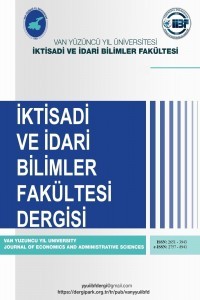TERÖRLE MÜCADELEDE SOSYAL AĞ ANALİZİ TEKNİKLERİNİN KULLANILMASI
9/11 saldırıları sonrası terör örgütleri üzerinde yapılan birçok çalışma, terör örgütlerinin merkezsiz yapılar olarak yapılandığını göstermektedir. Her ne kadar bu örgütlerin hiyerarşik yapılanmaları mevcut olsa da terör eylemlerini, merkezden bağımsız, hücre tipi yapılanmalar gerçekleştirmektedir. Bu hücreler, örgütün ideolojisini takip eden, bu amaçla terör faaliyetlerini hayata geçiren; fakat bunları yaparken merkezden emir alma ihtiyacı duymayan yapılardır. Hiyerarşik yapıları yok etmek için kullanılan geleneksel yöntemler, merkezsiz örgütlerle mücadelede yeterli olmayacaktır. Hücre yapılanması kuvvetli olan bir terör örgütünün lideri etkisiz hale getirilse bile örgüt, eylemlerine devam edebilecektir. Terör hücreleri, birbirleri ile bağlantıya geçebildikleri sürece faaliyetlerini sürdürebilir. Hücre tipi yapılanmalar, toplum içerisinde terörist kimliğini saklayarak, oldukça sıradan görünmeye çalışan terör örgütü mensuplarından oluşmaktadır. Bu tip örgüt üyelerini tespit etmek oldukça zordur. Sosyal ağ analizi yöntemleri ile örtülü örgüt ağı ortaya çıkartılabilir. Örgüt, aktörler arasındaki iletişimin ortadan kaldırılmasıyla faaliyetlerini yapamaz hale getirilebilir. Doğru aktörlerin etkisiz hale getirilmesi, örgütü felç duruma sokacaktır.
Anahtar Kelimeler:
Ağ bilimi, sosyal ağ analizi, terör ağları, terör ağlarının analizi, terörle mücadele.
Use of Social Network Analysis Techniques Fight Against Terrorism
Many studies on terrorist organizations after the 9/11 attacks show that, terrorist organizations are structured as decentralized structures. Although these organizations have hierarchical structures, terrorist acts are carried out by cell-type structures which are independent from the center. These cells follow the organization's ideology and carry out terrorist activities for this ideology, and while doing this, they do not need to take orders from the hierarchical managers. Traditional methods used to destroy hierarchical structures will not be sufficient in the fight against decentralized organizations. Even if the leader of a terrorist organization with a strong cell structure is neutralized, the organization will still be able to continue its actions. Terror cells can continue their activities as long as they can communicate with each other. Cell-type structures consist of members of terrorist organizations who try to appear quite ordinary by hiding their terrorist identity in the society. It is very difficult to identify the members of this type of organization. A covert organization network can be revealed by social network analysis methods. The organization can be rendered incapable of its activities by eliminating the communication between the actors. Neutralizing the right actors will paralyze the organization.
Keywords:
Network science, social network analysis, terrorist networks, terrorist networks analysis, fight against terrorism.,
___
- Airbus Defence and Space. (2020). Mapping Extremist Communities: A Social Network Analysis Approach. Riga: NATO Strategic Communications Centre of Excellence.
- Amaral, L., & Ottino, J. (2004). Complex Networks: Augmenting the Framework for the Study of Complex Systems. The European Physıcal Journal B, 38, 147-162.
- Anklam, P. (2007). Net Work: A Practical Guide to Creating and Sustaining Networks at Work and in the World. Amsterdam, Boston, Heidelberg, London, New York, Oxford,
- Paris, San Diego, San Francisco, Singapore, Sydney, Tokyo : Elsevier.
- Barabasi, A. L. (2002). Linked: The New Science of Networks. Cambridge, Massachusetts: Perseus Publishing.
- Barabasi, A.-L. (2013, 02). Network Science. s. 1-3.
- Bonacich, P. (1987). Power and Centrality: A Family of Measures. American Journal of Sociology, 92(5), 1170-1182.
- Borgatti, S. P., Everett, M. G., & Johnson, J. C. (2013). Analyzing Social Network. Los Angeles: SAGE.
- Carley, K. M., Reminga, J., & Kamneva, N. (2003). Destabilizing Terrorist Networks. NAACSOS conference proceedings. Pittsburgh: Carnegie Mellon University.
- Erdös, P., & Renyi, A. (1959). On Random Graphs I. Publicationes Mathematicae(6), 290-297.
- Gürsakal, N. (2009). Sosyal Ağ Analizi. Bursa: Dora.
- Gürsakal, N. (2017). Büyük Veri. Bursa: Dora.
- Granovetter, M. S. (1973). The Strength of Weak Ties. American Journal of Sociology, 78(6), 1360-1380.
- Kilduff, M., & Tsai, W. (2003). Social Networks and Organizations. London: Sage Publications.
- Knoke, D., & Yang, S. (2008). Social Network Analysis. California: Sage Publications Inc.
- Krebs, V. E. (2002). Mapping Network of Terrorist Cells. Connections, 24(3), 43-52.
- Milgram, S. (1967). The Small World Problem. Psychology Today, 1(1), 61-67.
- Newman, M. E. (2010). Networks: An Introduction. Oxford: Oxford University Press.
- Podolny, J., & Baron, J. N. (1997, Ekim). Resources and Relationships: Social Networks and Mobility in the Workplace. American Sociological Review, 62, 673-693.
- Ressler, S. (2006). Social Network Analysis as an Approach to Combat Terrorism: Past, Present, and Future. Homeland Security Affairs, 2(2).
- Rothenberg, R. (2002). From Whole Cloth: Making Up the Terrorist Network. Connections, 24(3), 36-43.
- Sageman, M. (2004). Understanding Terror Networks. Philadelphia: University of Pennsylvania Press.
- Scott, J., & Carrington, P. J. (2011). The SAGE Handbook of Social Network Analysis. Los Angeles: SAGE.
- Sparrow, M. K. (1991). The Application of Network Analysis to Criminal Intelligence: An Assessment of the Prospects. Social Networks(13), 251-274.
- T.C İçişleri Bakanlığı. (2017). PKK/KCK Terör Örgütünün Suriye Kolu: PYD/YPG. Ankara: T.C İçişleri Bakanlığı.
- Tüzüntürk, S. (2019). Ağ Bilimi. Bursa: Dora.
- Tang, K.-K., & Wagner, A. (2010). Measuring Globalization Using Weighted Network Indexes. 31st General Conference of The International Association for Research in Income and Wealth. St. Gallen, Switzerland: School of Economics, University of Queensland.
- Tsai, M., & Kilduff, W. (2003). Social Networks and Organizations. London. Thousand Oaks, New Delhi: SAGE Publications.
- TUİK. (2022, 06 02). https://www.tuik.gov.tr/: https://data.tuik.gov.tr/Bulten/Index?p=Adrese-Dayali-Nufus-Kayit-Sistemi-Sonuclari-2021-45500 adresinden alındı
- Watts, D. J. (1999). Networks, Dynamics, and the Small-World Phenomenon. American Journal of Sociology, 105(2), 493-527.
- Yarlagadda, R., Felmlee, D., Verma, D., & Gartner, S. (2018). Implicit Terrorist Networks: A Two-Mode Social Network Analysis of Terrorism in India. Social, Cultural, and Behavioral Modeling - 11th International Conference, SBP-BRiMS (s. 340-347). Washington,: Springer Verlag .
- ISSN: 2651-3943
- Başlangıç: 2016
- Yayıncı: Van Yüzüncü Yıl Üniversitesi
Sayıdaki Diğer Makaleler
DİJİTAL DÖNÜŞÜM, ENDÜSTRİ 4.0 VE KADIN İSTİHDAMI
Yener ALTUN, Ahmed Hassan ABDULLAH
BIST 30 VADELİ İŞLEM GETİRİSİ VE YATIRIMCI RİSK İŞTAHI: GRANGER NEDENSELLİK ANALİZİ
Nazan GÜNGÖR KARYAĞDI, Nurettin KOCA
TERÖRLE MÜCADELEDE SOSYAL AĞ ANALİZİ TEKNİKLERİNİN KULLANILMASI
PHİLLİPS EĞRİSİNİN TÜRKİYE VE GELİŞMİŞ EKONOMİLER AÇISINDAN İNCELENMESİ
Nigar ALEV, Muhyettin ERDEMLİ, Bengü KAYAPALI
Ahmet Melih EYİTMİŞ, Fadime SEZER
YENİLENEBİLİR ENERJİ VE GELİR DAĞILIMI İLİŞKİSİ: AB ÜLKELERİNDEN KANITLAR
